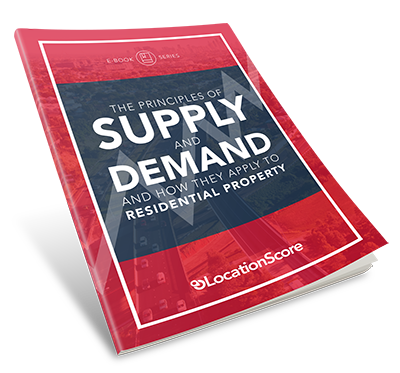×

The Principles of Supply and Demand and How They Apply to Residential Property
We Only Send You Awesome Stuff

LocationScore
|
May 15, 2017
Bryce: Hey folks! Bryce Holdaway here. Over here I've got Ben Kingsley and also the founder of DSR Data, and we want to talk all things Location. The first question we want to ask Jeremy is—he's very, very interested in lots of research and lots of data, mate—we're talking about an essential need, property's an emotional asset, so do we actually really need this data?
Jeremy: No. You don't need capital growth. You don't need rental yield. You don't need the data. Yeah, you can have miserable investments Bryce, knock yourself out.
Bryce: But I mean, it's not a managed fund, it's not shares, where there's a lot of technical data; property's essentially something people need to put a roof over their head. It does make for a good investment, but I mean, most people don't go to the level of detail that you're going to. Why did you start DSR Data?
Jeremy: Well, after investing myself, and realising what I was researching, I knew that I needed to collect certain information. It all comes down to supply and demand for any commodity or service—the price of it is determined purely by supply and demand—so I was after supply and demand indicators for property investing. And there are quite a large number of them, so I had to process a lot of them, for an entire country, to find the best locations to invest. That meant doing something quite complicated—
Ben: And that's the best part of it. I mean, ultimately, what we're trying to do here is aggregate data to try and find the best opportunities. Now, we talk about borderless investing and those types of things, in all the sorts of education that we give—this is a way in which we can funnel that down into those variables, isn't?
Jeremy: Yeah. It's a great way of processing an enormous amount of information very quickly. Computers can do that a lot better than a human brain can. They can acquire a large amount of information, and automating that process obviously makes property investment research so much more powerful.
Bryce: Well, there's over 15,000 suburbs and over 9 million dwellings, so you’re right—being able to analyze that in real time, quickly, is a real advantage. But when you first started your mission to measure the data, what did that look like for you? How did you start it off?
Jeremy: It was really a case of what's available. So I had limited access to information. It was things like Yields and Auction Clearance Rates … really, it was whatever I could get my hands on. Then I realised, “what I'm chasing here is supply and demand indicators”. I'd start filtering out some of those less-useful things I'd know about a suburb, and just try to target how much the indicator reflected demand or supply, or a bit of both.
Bryce: Ben, you're a real research nut yourself too.
Ben: Oh, I love it. I love the data.
Bryce: It's bringing it all together. When you're talking about equities and shares; they've actually got really sophisticated research models. But when it comes to residential real estate, it's in the dark ages.
Ben: Now, there's no doubt that Jeremy pioneered a lot of the thought processes that a lot of us where having, in terms of how do we quickly and easily aggregate all that information. When you're buying in one state or one area, it's a little bit easier—but you then have that little thing in the back of your head going, Is this the right area to go in; is there a better area in Australia that my money—. I mean, at the end of the day, as you talk about Bryce, it's just a “bricks and mortar bank account”. And we're looking out for out-performance, we're looking for capital growth. So I think from that point of view, what I love about—when I identified the DSR data that Jeremy was putting together—I wanted to make that connection. I wanted to make that partnership. To make sure that we understood there's this fantastic engine with data that we can analyze. We've got data back to 2010. And to be able to do that, to put that together, and then bring it to the general public for them to be able to digest in a simple and easy way; it just made perfect sense to me.
Bryce: So Jeremy, it's now evolved to be a very powerful engine for people to be able to identify where they should start their research. What does the basis of DSR Data look like? What variables are you looking to analyze to get to that initial starting point?
Jeremy: Okay, so the obvious ones—everyone knows about Auction Clearance Rates. Auction Clearance Rates are quite high when the market demand for property is higher than supply. There are other less known indicators, like the number of people that are searching online versus how many properties are available online (Online Clearance Rates). There are things like Yield and Vacancy Rate, which most people are familiar with. Perhaps they’re not so familiar with Vendor Discounting or Days on Market. So we just start with the basics, and analyze each metric to see whether it has an influence or correlation with capital growth. And then munge it all together!
Ben: What I like about it is, it's not just an average weighting—different variables get different weightings to try and get that precision. This is the subject matter expertise, which comes to the table. This type of partnership is perfect for allowing us to help people have a look, just vet suburbs, relatively easily; or aggregate down to suburbs to start doing more research. I'm delighted that LocationScore is going to be able to provide that, at a cost-effective way, for people not to make mistakes in property.
Bryce: So why don't you get the LocationScore Advantage for yourself. Go to our home page, put in your suburb, and within seconds you'll find out what the LocationScore is for your suburb! And you can take advantage of all the years of Jeremy's research to see how that impacts on your house.
Most Popular Blog Posts